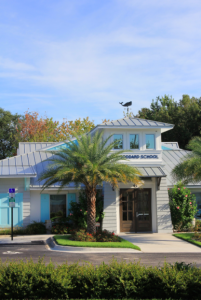
The Goddard School in Ponte Vedra Beach was constructed from an existing building that was entirely gutted and remodeled. It features a standing seam metal roof manufactured by Metal Sales and installed by Ford Roofing Systems. Photos: Jacob Maust, Ford Roofing Systems Inc.
“Almost everything we do is kind of odd, weird and unique,” says Jay Maust, president and owner of Ford Roofing Systems Inc. in Ponte Vedra Beach, Fla. The company excels in high-end commercial and residential projects featuring metal, tile, slate and asphalt shingle roofing.
A recent metal roof installation in Ponte Vedra Beach was more straightforward than many of the company’s projects, notes Maust, but it has the aesthetics and architectural flair the company is known for. The project came to the company like all of the rest of the company’s jobs do: as a referral from an existing customer.
When the relative of a previous residential roof customer decided to completely gut, renovate and expand a building to put up a teaching preschool known as the Goddard School, Maust was called in to consult on the project, come up with a roof design and install it. The result was a standing seam metal roof that provides the durability and energy efficiency the school requires.
The existing shingle roof was torn down to the trusses, and any damaged trusses were replaced. After new wings were added, the building envelope was insulated with spray foam. New plywood decking was installed, and after the deck passed the county inspection, Maust dried the building in with Boral Tile Seal self-adhering underlayment. “It has great thermal properties to it,” he says. “In my opinion, it is the best peel and stick on the market.”
The next step was to install painted metal perimeter wall flashings for the metal roof system that would also serve as stops for the HardiePlank and stucco siding. “It not only provides waterproofing protection but creates a tie-in for our system,” says Maust. “We call it a receiver flashing. It provides a nice, straight line where the siding or stucco ends. There is typically blue plastic that covers the metal, and after the siding is installed, you just peel the plastic sheeting off, and any paint or residue that might have gotten on the metal is peeled off with the plastic. And the end you have a beautiful piece of metal that enhances the look of the building—and it’s a water barrier.”
The standing seam roof was manufactured by Metal Sales Inc. On jobs such as this one, the project superintendent typically measures the roof by hand and prepares a cut list for the manufacturer. Metal Sales shipped the finished panels to the site, including 24-gauge galvalume panels painted in Kynar Silver Metallic, drip edge, hip and ridge panels, and headwall flashing.
Precise Execution
Since the front entryway was still under construction, roofing crews began at the back of the building and worked their way forward. One hurdle was formed by the addition of a back wing, which had a primary support beam that intruded on a designed valley. Since the support could not be moved, Maust decided to change the slope of valley to avoid the potential eyesore.
Architectural details included shed dormers over the doorways and windows, as well as gable dormers with false louvers.
Proper placement of penetrations on metal roofs is critical, notes Maust, and the company takes pains to ensure that penetrations are kept to a minimum and are properly designed and executed. Crews make sure plumbing stacks are in the center of a panel and don’t interfere with the ribs. When plumbers rough in the stacks, roofing crews make sure the last section of pipe can be rotated to ensure it is in the center of a panel before the final cuts are made. “We make them go through this extra step,” Maust says. “If they won’t do it or can’t do it, we’ll do it for them.”
Coordinating work with representatives of other trades on the project was difficult, but it is necessary part of the process, according to Maust. Ford Roofing workers made sure to be on hand to assist framers, as well as contractors installing siding, stucco, fascia and HVAC equipment. “That is our roof, and we don’t want anyone else walking on it, period,” Maust says. “We’ll install weather vanes, cupolas—whatever’s going up there.”
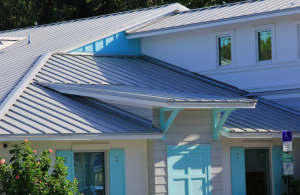
The standing seam metal roof was installed after the building envelope was insulated with spray foam. The result is a durable roof system that helps ensure energy efficiency for the building. Photos: Jacob Maust, Ford Roofing Systems Inc.
The company built a curb for one of the HVAC fan units, and flashed in another that had a factory-installed curb to ensure they looked identical. “We went up there and sealed it in and flashed it,” Maust notes. “We made it look like it was part of the roof.”
For those forced to walk on the panels, rituals include knocking boots on the ladder and wiping the soles with a towel to ensure no sand or grit could possibly mar the finish. “We use foam tubes on our ladders so we don’t scratch the paint,” Maust explains. “It’s a learned process, and we’ve learned a lot of things over the years.”
Safety is always the top priority on every project. “On steep–slope jobs like this one, everyone wears harnesses and is tied off to their own bracket, which is properly attached to a truss,” Maust notes. “We are always checking on each other. Sometimes it’s hard to see if someone is tied off when they are on the top of the roof, so we developed this little motion where someone on the ground will make a hand gesture, and the person on the roof will pull up his safety line to demonstrate they are tied off.”
The installation on this project went like clockwork, according to Maust. “I’ve been doing this since I was 14,” he says. “The key is logistics. Is there stress sometimes? Absolutely. You just have to pace yourself.”
Maust is detail-driven, but he realizes it’s people who must execute the error-free, eye-catching projects that generate referrals. “Success comes from having guys in the field that care,” he says. “They understand very clearly that if they do a good job, this job is going to lead to another job. They get that. I also get that.”
The key is to not only build strong roofs but strong relationships. “I’m a very social person when it comes to my homeowners and my contractors,” Maust says. “If I’m working for a contractor, I want to meet the homeowner and help them select their tile. I want my reps, my builders, my homeowners to embrace a project together. I want everybody to know everybody. You develop these friendships and relationships, and that’s where great projects and great referrals come from.”
“That’s how I get my work,” Maust concluded. “All of my projects come to us through word of mouth. I’ve never placed an ad.”
TEAM
Architect: Dig Architecture, Jacksonville, Fla., Dig-architecture.com
General Contractor: Benchmark Commercial Group, Jacksonville Beach, Fla., Benchmarkcommercialgroup.com
Roofing Contractor: Ford Roofing Systems Inc., Ponte Vedra Beach, Fla., Fordroofingsystems.com
Metal Roof System Manufacturer: Metal Sales Inc., Metalsales.us.com
Underlayment Manufacturer: Boral Roofing, Boralamerica.com/roofing

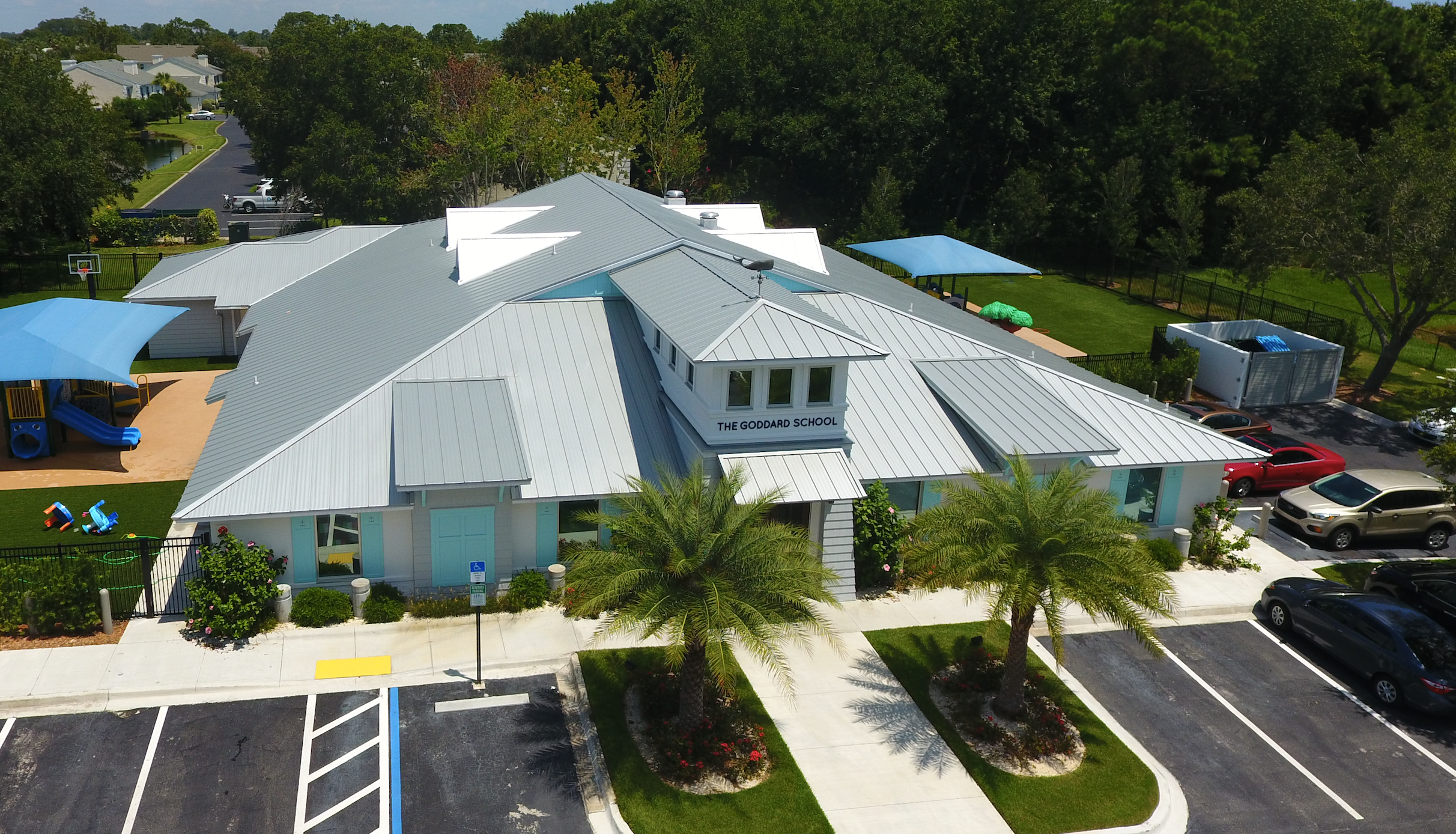
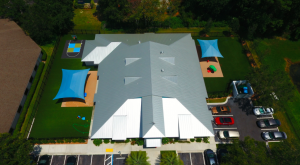
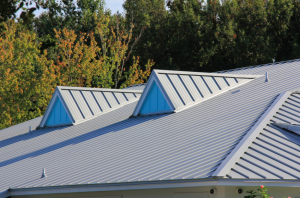
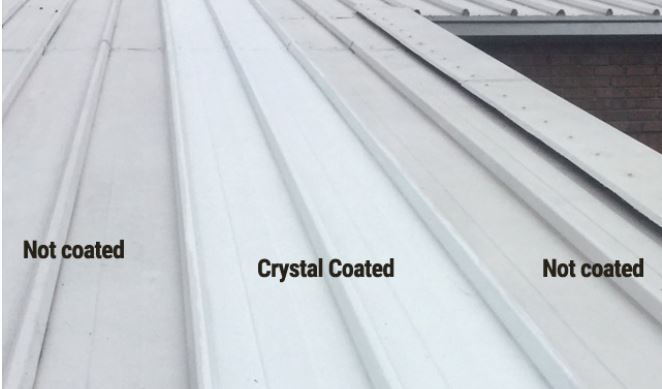

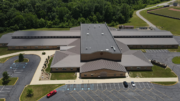
Be the first to comment on "Metal Roof Provides Durability, Energy Efficiency for Florida Preschool"